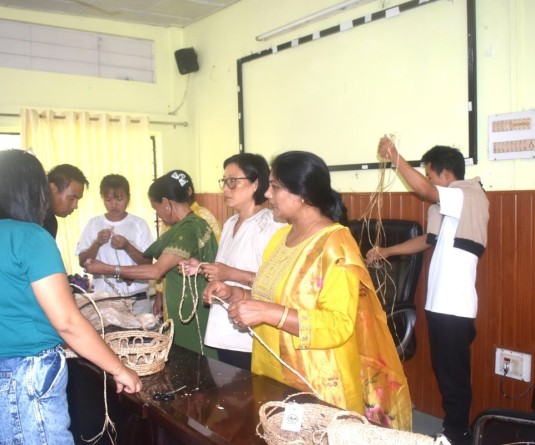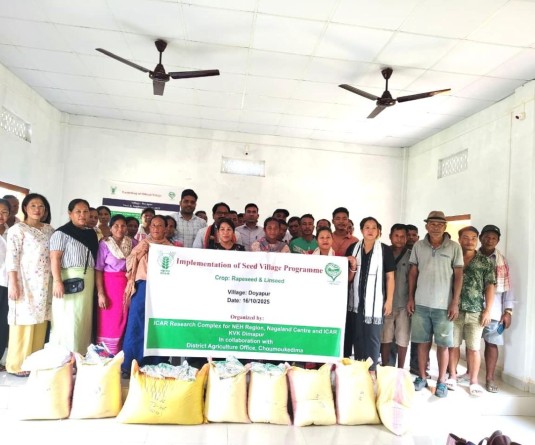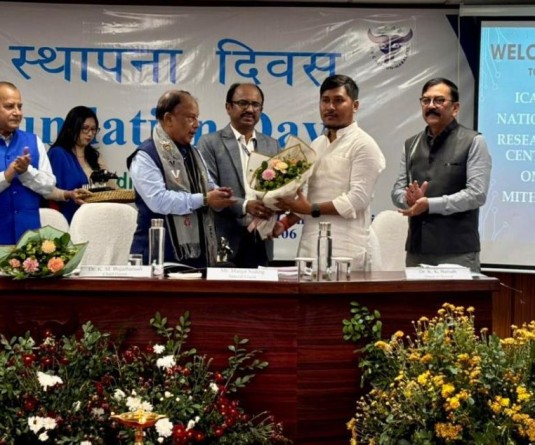
Natural resources can be defined as the resources that exist (on the planet) independent of human actions. Life on this planet depends upon a large number of services provided by the nature, which are known as Natural Resources. Thus water, air, soil, minerals, coal, forests, crops, and wildlife are all examples of natural resources. Sustained agricultural productivity is closely linked to the quality of ecosystem services (benefits communities obtain from nature) that natural resources provide. Loss of ecosystem services results in the reduced productive capacity of farms and lower yields which affect the net incomes of farmers. Over-exploitation of natural resources is instrumental in the plateauing yields in irrigated agriculture systems. It perpetuates poverty and hunger in dry lands.
Natural resources provide rural communities with fuel wood, fodder, food, and other materials. They can be a source of non-farm income through ancillary activities such as tourism. Thus, conservation and appropriate use of land, water, biodiversity, and forest resources are vital for sustaining the profitability of agriculture and maintaining livelihoods and social well-being in rural communities.
Why natural resources are stressed.
• Land resources and land-use change: Land as a resource, land degradation, landslides (natural & man-induced), soil erosion, and desertification.
• Forests & forest resources: Impacts of deforestation, mining, dam building on the environment, forests, biodiversity, and tribal populations.
• Water resources: Use and over-exploitation of surface and groundwater, floods, drought, conflicts over water (international & interstate). Reports indicate that around 54 percent of India falls under high and extremely high water stress regions and groundwater wells are decreasing. Farmers in several regions face acute water shortages.
• Food resources: World food problems, changes caused by agriculture and overgrazing, effects of modern agriculture, fertilizer-pesticide problems, waterlogging, salinity. There is also an erosion of agro-biodiversity - seeds, crop varieties, and livestock -due to over-emphasis on select high-yielding varieties that jeopardise food and nutrition security.
• Energy resources: Renewable and non-renewable energy sources, use of alternate energy sources, growing energy needs.
Scope to manage natural resources
Depending upon the availability of natural resources can be divided into two categories, Renewable and Non-renewable resources. Renewable resources can recycle, reproduce and replace. Examples are sunlight, animals and plants, soil, water, etc. and non-renewable resources are minerals, and fossil fuels. On the other hand, Natural resources can also be classified as biotic and abiotic. Biotic resources are forest, agriculture, fish and wildlife and abiotic resources petrol, land, minerals etc.
Managing Natural resources:
• Balanced consumption of natural resources: the consumption of resources per capita (per individual) in the developed countries is up to 50 times greater than in most developing countries. Advanced countries produce over 75% of global industrial waste and greenhouse gases.
• Planning for appropriate land use: Land is a major resource, needed not only for food production and animal husbandry but also for industry and growing human settlements. These forms of intensive land use are frequently extended at the cost of ‘wild lands’, our remaining forests, grasslands, wetlands and deserts. This demands a pragmatic policy that analyses the land allocation for different uses.
• The need for sustainable lifestyles: Human standard of living and the health of the ecosystem are indicators of sustainable use of resources in any country or region. Ironically, both are not in concurrence with each other. Increasing the level of one usually leads to degradation of the other.
Over all the most important natural resources need to be taken for conservations are:
• Air: Clean air is important for all plants, animals, and humans to survive on this planet. So, it is necessary to take measures to reduce air pollution.
• Water: 70% of the Earth is covered in water and only 2 % of that is freshwater. Initiatives to educate and regulate the use of water should be taken.
• Soil: Soil is composed of various particles and nutrients. It helps plants grow
• Iron: It is made from silica and is used to build strong weapons, transportation and buildings
• Forests: As the population increases, the demand for housing and construction projects also increases. Forests provide clean air and preserve the ecology of the world.
Opportunities to manage natural resources
• Land use planning and sustainable land management practices and multi-stakeholder dialogue is the key. Strengthening capacities, especially at block and district levels, for the development of natural resource plans, implementation, and ownership of the interventions are necessary. Plans need to be developed based on the characterization of the bio-physical resources, with an understanding of resource variability and dynamics of socio-economic realities
• An approach that recognizes the functional linkage between soils, water, biodiversity, forests and its impact on ecosystem services provided is needed. A re-emphasis on the watershed approach that integrates multiple resource use and conservation will be helpful.
• Association between sustainably managing biophysical resources and improved agricultural productivity and equity need focus. Emphasis must be laid on people's participation and the use of local knowledge and practices such that resource conservation measures are developed in ways that contribute to the socio-economic well-being of communities.
• Agriculture operates on a multifunctional scale and social and economic functions are important, its ecological functions and impacts are also significant. Unless the natural resource base is managed sustainably and in ways that benefit the local populations, improve system productivity, cultivate agro-ecosystem resilience and maintain ecosystem services, long-term gains from agriculture development for the economy, farmer livelihoods and rural development will not be possible. A turnaround in the fortunes of agriculture, therefore, requires policies and institutional arrangements that pay heed to farmers as well as the needs of the environment.
• Nevertheless, the resolution of natural resource challenges will demand new and creative approaches by stakeholders with diverse backgrounds, skills and priorities. Capabilities for working together at multiple scales and across different social and physical environments are not well developed. Community-based partnerships with the private sector, now in their early stages of development, represent a new and promising way forward.
The following high priority NRM options for action are essentials
• To identify and address some of the underlying causes of declining productivity embedded in natural resource mismanagement, and develop new multidisciplinary approaches for a better understanding of the complexity in NRM. Part of this process will involve the cost-effective monitoring of trends in the utilization of natural resource capital.
• Strengthen human resources in the support of natural capital through increased investment (research, training and education, partnerships, policy) in promoting the awareness of the societal costs of degradation and value of ecosystems services.
• Promote research to facilitate less exploitative NRM and better strategies for resource resilience, protection and renewal through innovative two-way learning processes in research and development, monitoring and policy formulation.
• Create an enabling environment for building NRM capacity and increasing understanding of NRM among stakeholders and their organizations in order to shape NRM policy in partnership with public and private sectors.
• Develop networks among farmer organizations, NGOs, government, private sector to facilitate long-term natural resource management to enhance benefits from natural resources for the collective good.
• Connect globalization and localization pathways that link locally generated NRM knowledge and innovations to public and private.
• Active participation among various stakeholders across multiple scales, the misuse of natural capital can be reversed and the judicious use and renewal of water bodies, soils, biodiversity, ecosystems services, fossil fuels and atmospheric quality ensured for future generations.
Conclusion: The agrarian crisis from its roots necessitates attention to the important aspect of the degradation of natural resources. Both irrigated and dry land agro-ecosystems in India face serious degradation or mismanagement of soil, water, forest and biodiversity resources. In the irrigated systems, which constitute 35% of farming, high input and intensive mono-cropping cultivation systems have predominated, resulting in water scarcity and pollution, soil degradation owing to heavy and skewered fertiliser use, loss of organic matter and agro-biodiversity. Dry land farm areas receive unpredictable rainfall and experience soil erosion and degradation, water scarcity and drought. The reluctance to harness diversity that exists in dry lands and the application of inappropriate practices in landholdings further degrades the natural resource base. Appropriate location-specific land and water management are an option for the sustainable development of Agriculture.
References:
1. S.D Sarma, 2018. Preserve natural resources, promote farming. The Tribune. Published on 1st March, 2018. https://www.teriin.org
2. https://www.sbsc.in/pdf/resources/1585913536_Unit_3.pdf
3. https://www.greenfacts.org
Article issued by LK Baishya, Z Kawikhonliu, Christy BK Sangma and Jyotish Barman, ICAR Research complex for NEH Region, Nagaland Centre, Medziphema






